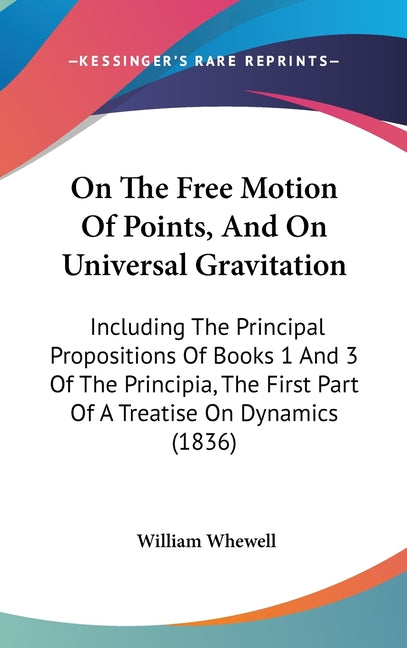1
/
of
1
On The Free Motion Of Points, And On Universal Gravitation: Including The Principal Propositions Of Books 1 And 3 Of The Principia, The First Part Of
On The Free Motion Of Points, And On Universal Gravitation: Including The Principal Propositions Of Books 1 And 3 Of The Principia, The First Part Of
Regular price
$44.95 USD
Regular price
$49.95 USD
Sale price
$44.95 USD
Unit price
/
per
Shipping calculated at checkout.
223 in stock
Couldn't load pickup availability
Descriptions
Descriptions
On The Free Motion Of Points, And On Universal Gravitation: Including The Principal Propositions Of Books 1 And 3 Of The Principia, The First Part Of A Treatise On Dynamics (1836) is a book written by William Whewell. The book is a detailed exploration of the principles of motion and gravitation, as laid out in Isaac Newton's famous work, the Principia. Whewell's book is divided into two main sections. The first section deals with the free motion of points, or the movement of objects in space without any external forces acting upon them. Whewell examines the laws of motion that govern such movement, and explores the mathematical principles that underpin them. The second section of the book is concerned with universal gravitation, or the force that attracts all objects in the universe towards one another. Whewell explores the nature of this force, and how it affects the motion of objects in space. He also delves into the mathematical principles that describe the behavior of gravitational forces. Throughout the book, Whewell draws heavily on the work of Newton, particularly his Principia. He includes detailed explanations of many of the key propositions from Books 1 and 3 of the Principia, and uses these as a basis for his own analysis and exploration of the principles of motion and gravitation. Overall, On The Free Motion Of Points, And On Universal Gravitation: Including The Principal Propositions Of Books 1 And 3 Of The Principia, The First Part Of A Treatise On Dynamics (1836) is a detailed and rigorous exploration of the principles of motion and gravitation, and an important contribution to the field of physics.This scarce antiquarian book is a facsimile reprint of the old original and may contain some imperfections such as library marks and notations. Because we believe this work is culturally important, we have made it available as part of our commitment for protecting, preserving, and promoting the world's literature in affordable, high quality, modern editions, that are true to their original work.
Share

